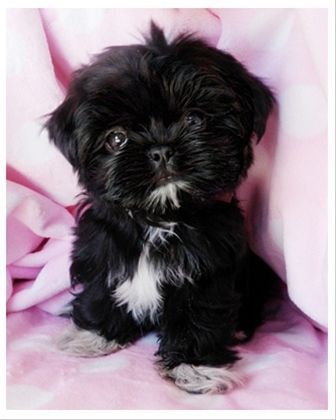
While there are many officially recognized color combinations in the Shih Tzu (the breed standard writes, in fact, that all colors are permissible), some fans of the breed feel that black and white is among the most popular if only because it’s so striking. These dogs aren’t white dogs with black markings, mind you, they’re black dogs with white markings, and this is true whether the dog is 5% black or 95% black.
White appearing on a black dog is determined by the S locus (the spotting gene) in all cases except for extreme whites when the dog is almost entirely white save for a tiny bit of another color; it occurs in the womb and on certain places on a dog, i.e., the paws, tail, muzzle and the middle of the chest, a so called “tuxedo” pattern. From there, it spreads out via a predetermined genetic secret known only to the dog (winkie winkie), but it’s that S-locus that determines where and how far the markings spread.
Black and white Shih Tzus can be classified by the amount of white markings they contain. Dogs who are half black and half white are called “parti-piebald,” and dogs who have more black than white coloring are called “Irish mark piebald.” Shih Tzus with mostly white coloring and a wee bit of black are called “extreme piebald.”
There is one more name that we share out of fondness for its vividness. In ancient China, a Shih Tzu with a black body and white feet was known as “Hsueh Li Chan” which means, “Standing in Snow.”
For those interested in colors in this breed, here’s the link to an article written by Jim Peat back in 1985 makes the case that variations of type and temperament do exist within the colors.
Image found on Pinterest and happily credited upon receipt of information
